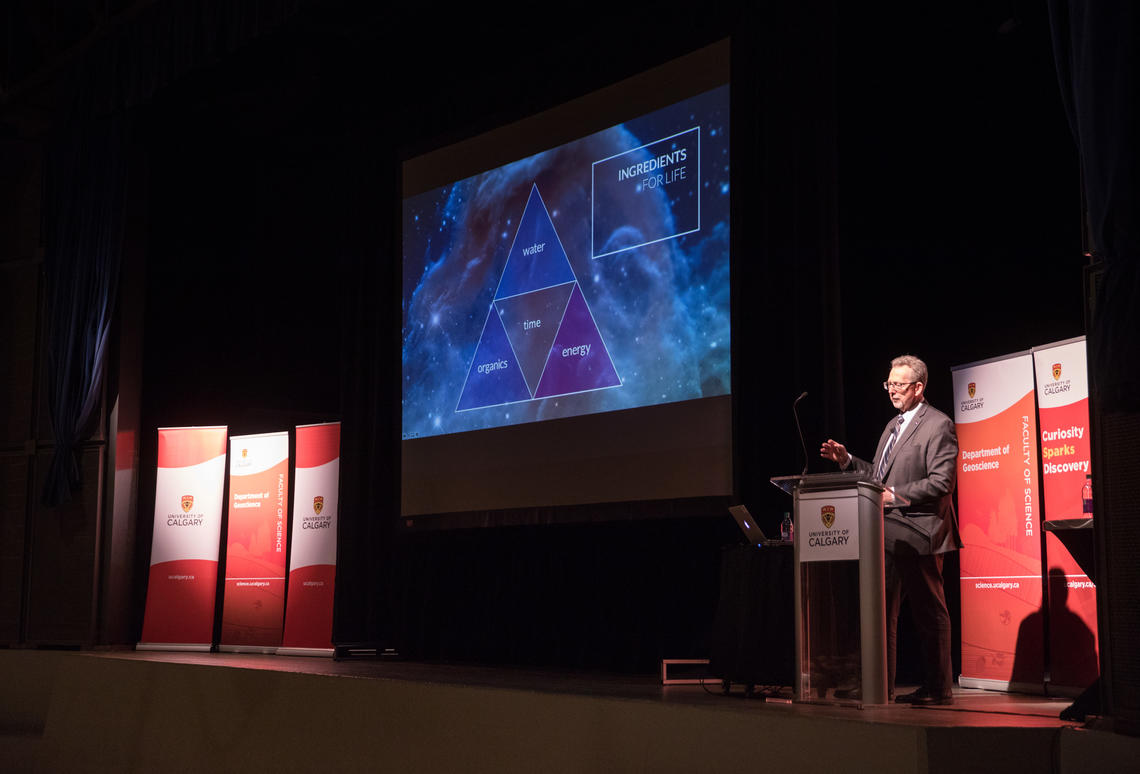
James Green, NASA's chief scientist, speaks at the Gallagher Colloquium Series on Feb. 20.
Adrian Shellard
Feb. 27, 2020

There’s a good possibility scientists will find life on another planet or moon within a decade or two, NASA’s chief scientist told more than 430 people during a public talk at the University of Calgary.
Deep-space probes, planetary landers and orbiting telescopes have already found evidence that Venus and Mars once were “blue planets” like Earth, with abundant surface water and habitable environments, Dr. James Green, PhD, said in a Gallagher Colloquium Series lecture on Feb. 20.
The free lecture series, sponsored by Calgary’s Gallagher family, is presented by the Department of Geoscience in the Faculty of Science.
“We have an enormous amount of circumstantial evidence, from Mars to Titan to Europa to exoplanets (which orbit other stars), that tell us we have planets that had habitable environments in the past, or can be habitable in the future, or are perhaps habitable today,” Green told the audience.
One of Jupiter’s moons, Europa, and two of Saturn’s moons, Titan and Enceladus, show signs of liquid water — a key ingredient for life — beneath their icy surfaces. All three moons appear to be in the “habitable state” capable of possibly supporting some type of life, he said.

James Green, NASA's chief scientist, speaks at the Gallagher Colloquium Series on Feb. 20.
Adrian Shellard
Green said several upcoming NASA missions have the potential to confirm that life once existed or still exists beyond Earth, including:
“We have not found life beyond Earth yet,” Green said. However, he added that his personal view is: “We will answer the question 'Are we alone?'. I can't imagine that the answer to that question is 'Yes.'"

Several upcoming NASA missions have potential to confirm life beyond Earth, Green says.
Adrian Shellard
Green has worked at NASA since 1980, including 12 years as director of its Planetary Sciences Division.
Born and raised in Iowa, he got interested in space at Burlington High School, which had a 12-inch telescope and an inspiring chemistry teacher, Don Vinson, who taught an astronomy course.
At the University of Iowa, Green did an undergraduate degree in astronomy. But he switched to space physics for his master’s and PhD, under the tutelage of planetary scientist Don Gurnett. He also took courses from James Van Allen, who discovered the two radiation belts (named after him) captured and held by Earth’s magnetic field.
Highlights of Green’s NASA career include creating the space agency’s internet, its Space Physics Analysis Network, in 1980. Another highlight was working as a safety diver in the large neutral buoyancy tank where astronauts train underwater for extra-vehicular activities in space.
In an interview during his day-long visit to campus, Green praised the University of Calgary’s nearly 50-year history of space research, which is focused on the near-Earth space environment and is now guided by the New Earth-Space Technologies research strategy.
“The Departments of Physics and Astronomy, and Geoscience here are pretty spectacular in space. I think they are Canada’s premiere space research group,” Green said.
UCalgary’s Space Research Group, which has participated in more than 20 national and international space missions, is recognized globally for designing and building space-borne and ground-based instruments to study space weather, the aurora and other phenomena.

James Green, second from left, with Bernhard Mayer, Chris Clarkson and Rajeev Nair, Geoscience.
Adrian Shellard
The Gallagher Colloquium Series, now in its fifth year, was the idea of Dr. Charles Henderson, PhD, then department head of geoscience, and is led by Dr. Chris Clarkson, PhD, professor and Ovintiv/Shell Chair in Unconventional Gas and Light Oil Research in the Department of Geoscience.
The Gallagher family also has supported the Gallagher Library at UCalgary, the Gallagher Fellowship in Geoscience, and many other university initiatives for more than 40 years. Legendary oilman and geologist Jack Gallagher was a generous supporter of UCalgary, and his sons Tom, BSc’75 Geology, and Fred, BSc’78 Geology — both alumni — followed in their father’s footsteps.
In 2018, the family renewed its support for the Gallagher Colloquium Series. “I see quite a few return attendees — alumni and other members of the community,” Clarkson says. “The feedback has always been positive.”
After Green’s lecture, a long line of people formed to chat with him. NASA’s chief scientist advised young people who want a career in space science to pursue advanced degrees. “Know what you’re good at and follow your dreams. But you have to be determined . . . 80 per cent of becoming successful is determination.”
Check out Green’s NASA podcast, Gravity Assist.